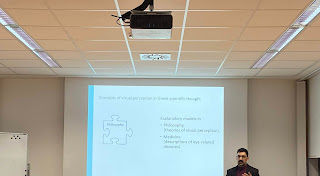Eye medication in ancient cultures: towards an ethnopharmacological analysis of Egyptian and Hippocratic treatment strategies. Report on the second Plenumssitzung of Wi/Se 19/20
A Blog post by David Usieto Cabrera.
Aleksandar Milenković, doctoral candidate in the Department of Classical Philology and Jonny Russell, doctoral candidate in Egyptology at the University of Leiden and associate doctoral candidate in Mainz, presented a talk related to their doctoral dissertations at the second Plenumssitzung of the winter semester on November 21, 2019.
The point of the
talk was eye diseases and their treatments. In the texts studied from both
traditions, minerals played a central role (contra to what you find elsewhere).
As Aleksandar showed, ancient Greek
texts mention diseases like eyelid disorders, squinting, impaired vision,
blindness, etc. Interestingly enough, copper was often used as a treatment. Jonny
on the other hand discussed pigments including the microbial activity of Galena,
and the specification for the prescription of wꜢḏ.w which is commonly translated as ‘malachite’ and sometimes
‘papyrus’ (citing discussions on the Science
in Ancient Egypt website of the Sächsische
Akademie der Wissenschaften zu Leipzig), but probably refers to any
greeny-blue substance (likely mineral) used as pigment for colouring (and
probably therefore also includes copper-based substances).
The focus of their
investigation was the potential motivations for the selection and application
of materia medica for eye-conditions.
It was shown that the understanding of pathogenesis differed between the
temporally disparate sources and was instead more coherent with prevailing
cultural/philosophical models. The socio-cultural bases of the uses of plants and other
natural remedies can be traced on a high number of societies around the globe.
Several cultures have documented their knowledge of the use of plants in an
extensive body of written sources.
Greek sources
The first
part of the talk focused on Ancient Greece. Aleksandar Milenković started out
with his PhD project: “Concepts of visual perception in Greek scientific
thought”. By using a philosophical perspective, eye envision was compared
in early philosophy (Alcmaeon, Empedocles, Democritus), and perceived
differently in antiquity (from the simplicity of water and fire, to atoms).
Philosophers like Empedocles, have used the eye as a metaphor, and from a more
scientific perspective, describing it as narrow vessels nourish with
purest moisture, in which the image appears.
Egyptian sources
Jonny Russell’s
project, ”Ancient Egyptian Ethnomedicine: Explanatory Models and their
Historical Contextualisation” focuses on historically contextualising the
ancient Egyptian perspective of models for internal human physiology and
pathogenesis and its link role as a potential motivator for the selection of materia medica. He referred to the Ebers
Papyrus, which has the largest collection of eye medications. This Papyrus is an Egyptian medical papyrus
of not only plants, but minerals and animal products, as well as magical
incantations knowledge dating to approx. 1550 BC. Among the oldest and most
important medical papyri of ancient Egypt, we find the Ebers Papyrus.
Jonny Russell's part of the talk showing Egyptian medical sources. Photo © David Usieto Cabrera
Aleksandar
and Jonny showed us, that there are similarities but also many differences
comparing texts from these two disciplines. To cite just some of them, while
the Greek model works with explicit theoretical information; the Egyptian model
works under an implicit theory (and explicit remedy). Furthermore, the most
common class of ingredients is mineral (for both ancient Egypt and Greece);
while in ancient Greece most common ingredients are copper(-related) and myrrh,
and also with alcohol employed; in Egypt were galena, pigments and resins with
no alcohol employed.






Kommentare
Kommentar veröffentlichen